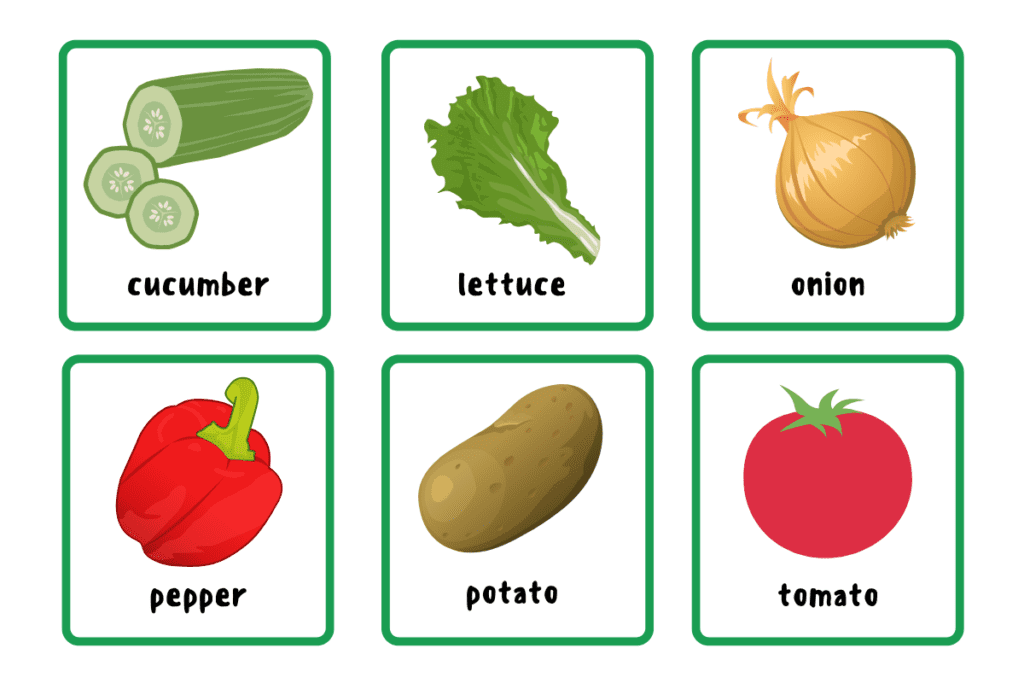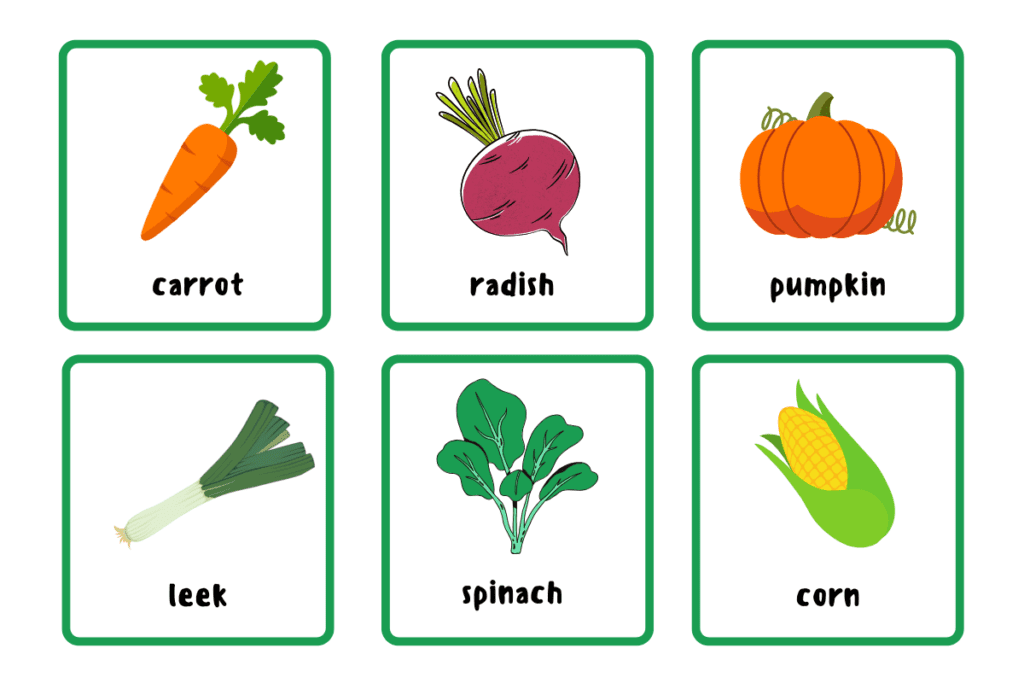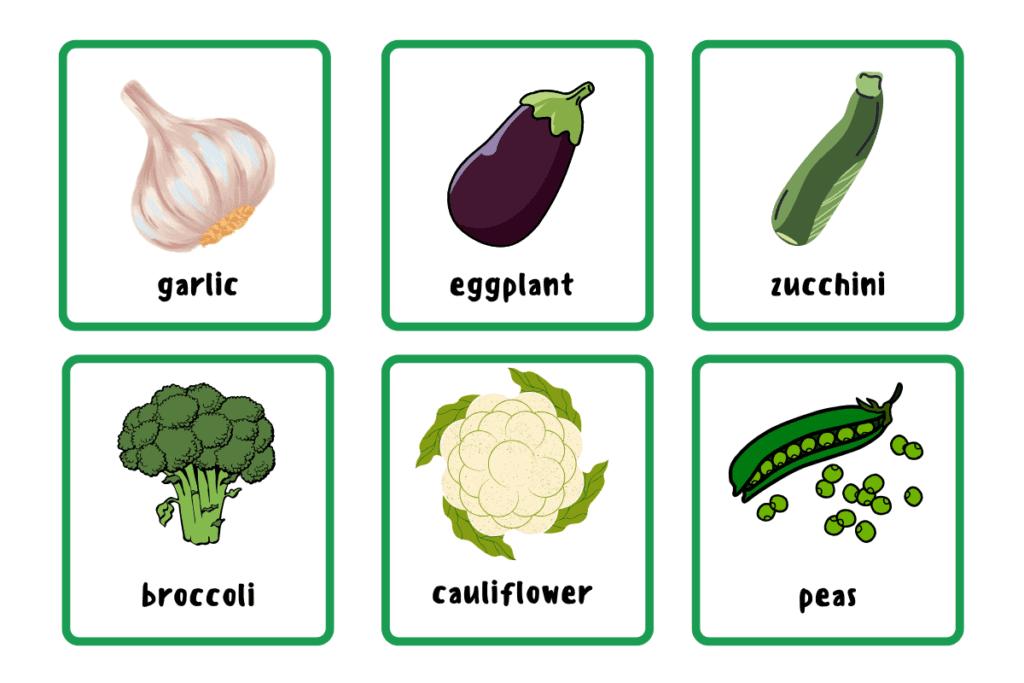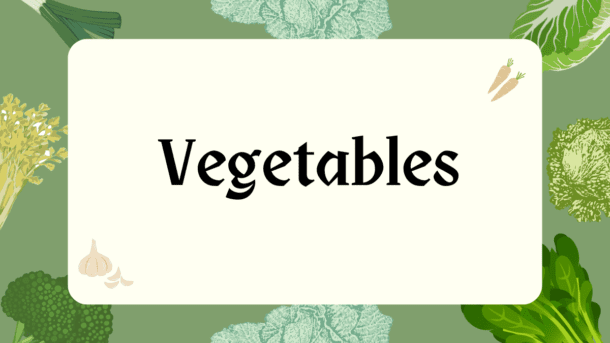Vegetables are essential to a balanced diet, providing vital nutrients and flavors to our meals. For English learners, understanding them can enhance culinary skills, vocabulary, and conversation abilities. This lesson focuses on vocabulary, health benefits, categorization, and cooking methods.



Here is a comprehensive list of vegetables names:
| Vegetable Names List | ||||
| Ash gourd | Beetroot | Broccoli | Cucumber | Celery |
| Bitter gourd | Pumpkin | Elephant yam | Carrot | Spring onion |
| Potato | Radish | Capsicum | Turnip | Bell peppe |
| Cluster beans | Artichoke | Green peas | Peppe | Apple gourd |
| Onion | pea | Cauliflower | leek | Ridge gourd |
| Spinach | Asparagus | Cabbage | Garlic | Mushroom |
| Lady’s finger | Green bean | Snake gourd | Zucchini | Sweet potato |
| Beans | Squash | Ivy gourd/Scarlet gourd | Green papaya | Corn |
| Pumpkin | Ginger | Broccoli | Drumstick | |
| White pumpkin | Snake beans/Yard long beans | Radish | Field beans/Broad beans | |
Types of Vegetables:
Leafy Green Vegetables:
- Spinach
- Cabbage
- Mint
- Spinach
- Kale
- Lettuce
- Collard greens
Tuber Vegetables
- Potato
- Elephant yam
- Ginger
- Greater yam
- Turmeric
- Purple yam
- Chinese potato
- Arrowroot
Cruciferous Vegetables:
- Broccoli
- Cauliflower
- Cabbage
- Bok choy
Root Vegetables:
- Carrots
- Turnip
- Radish
- White radish
- Celeriac
- Rutabaga/Swede
- Beets
- Sweet potatoes
- Parsnips
Allium Vegetables:
- Onions
- Garlic
- Shallots
- Leeks
Nightshade Vegetables:
- Tomatoes
- Peppers
- Eggplant
- Okra
Common Cooking Methods
- Boiling: Cooking vegetable in water. Example: Boil carrots until tender.
- Steaming: Cooking with steam for a softer texture. Example: Steam broccoli to retain nutrients.
- Roasting: Cooking in an oven for a deep flavor. Example: Roasted Brussels sprouts are delicious.
- Stir-frying is quickly cooking in a small amount of oil. For example, Stir-fried bell peppers make a great side dish.
Some examples of sentences using various vegetable:
- Carrot: She added shredded carrot to the salad for extra crunch.
- Broccoli: I like to steam broccoli and serve it with lemon juice.
- Spinach: He included fresh spinach in his smoothie for added nutrients.
- Tomato: The tomato sauce simmered on the stove, filling the kitchen with a delicious aroma.
- Cucumber: I sliced a cucumber to make a refreshing side dish for lunch.
- Bell Pepper: She chopped a red bell pepper and mixed it into the stir-fry.
- Potato: We roasted potatoes with garlic and herbs for dinner.
- Zucchini: Zucchini noodles are a great low-carb alternative to pasta.
- Cauliflower: He made cauliflower rice as a healthy substitute for grains.
- Eggplant: The eggplant parmediana was the highlight of the dinner party.
Discussing Vegetables in Sentences
- Descriptive Sentences: Learn how to use adjectives to describe vegetables.
- Fresh spinach is crunchy and mild.
- Sweet bell peppers add color to any dish.
- Cooking Preferences: Express likes or dislikes regarding vegetables.
- I love roasted beets, but I don’t like cooked cabbage.
- My favorite vegetable is asparagus, especially grilled.
Activity
- Fill in the blanks: Use the vocabulary words to complete the sentences.
- I like to eat _______ (leafy green) in my salads.
- _______ (root vegetable) is great for making fries.
- _______ (cruciferous vegetable) can be eaten raw or cooked.
Here’s a list of 50 vegetables:
- Carrot
- Broccoli
- Spinach
- Tomato
- Potato
- Onion
- Garlic
- Cucumber
- Bell pepper
- Lettuce
- Cauliflower
- Zucchini
- Eggplant
- Peas
- Radish
- Kale
- Cabbage
- Sweet potato
- Asparagus
- Mushrooms
- Brussels sprouts
- Celery
- Corn
- Beets
- Green beans
- Turnip
- Artichoke
- Arugula
- Leek
- Chard
- Endive
- Squash
- Okra
- Fennel
- Jicama
- Bamboo shoots
- Shallots
- Kohlrabi
- Parsnip
- Mung bean sprouts
- Watercress
- Butternut squash
- Bok choy
- Purslane
- Swiss chard
- Rutabaga
- Taro
- Acorn squash
- Chilies
- Palm heart
Other Vegetables:
- Tomatoes (technically a fruit, but often considered a vegetable)
- Cucumbers (technically a fruit, but often considered a vegetable)
- Peppers (technically a fruit, but often considered a vegetable)
- Olives (technically a fruit, but often considered a vegetable)
- Capers (technically a fruit, but often considered a vegetable)
- Rhubarb (technically a fruit, but often considered a vegetable)
pro tips for studying and memorize Vegetables in english:
- Categorize: Group vegetables into categories (e.g., leafy greens, root vegetables, legumes) for easier memorization.
- Use Flashcards: Create flashcards with pictures of the vegetable on one side and their names in English on the other, regularly testing yourself.
- Labeling: Label vegetables in your kitchen or grocery store with their English names to reinforce learning in a practical context.
- Daily Conversation: Incorporate vegetable names into daily conversations or recipes to strengthen retention.
- Active Recall: Regularly quiz yourself on the vegetables, using apps like Quizlet for additional practice.
- Visual Aids: Utilize charts or posters that display different vegetable and their names for visual reinforcement.
- Practice in Context: Cook recipes that require various vegetables, enabling you to learn their names in context.
- Engage with Games: Use vegetable-themed games or puzzles to make learning fun and interactive.
- Consistent Review: Set a schedule for regular review sessions to keep the information fresh in your memory.
Here are some frequently asked questions:
- How do I pronounce vegetable names?
- For pronunciation, online dictionaries and language apps often provide audio examples.
- What are some popular cooking vegetables?
- Popular cooking vegetables include onions, garlic, bell peppers, and zucchini.
- How can I learn vegetable names quickly?
- Use flashcards, videos, or cooking classes to reinforce learning through visualization and practical use.
- Where can I find lists of vegetable names in English?
- Online resources, educational websites, and language learning apps often provide comprehensive lists.
- Are there vegetables that are commonly mistaken for fruits?
- Yes, vegetables like tomatoes, cucumbers, and bell peppers are botanically fruits but commonly referred to as vegetables.
- How do I remember vegetable names in English?
- Try creating associations, using mnemonic devices, or practicing with apps to enhance memory.
Conclusion
Understanding vegetable vocabulary enriches your cooking and dietary knowledge. Remember to experiment with different vegetables and cooking methods to discover new tastes and healthy meal options.




